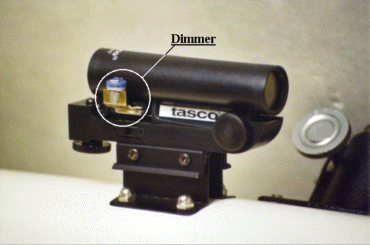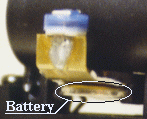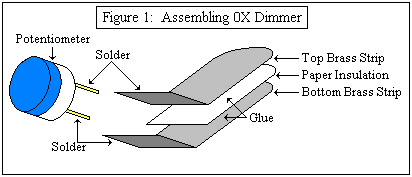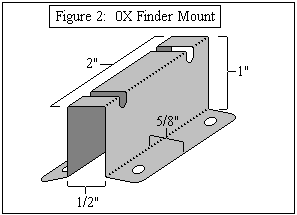A 0X Finder
by Thomas A. Jonard
Telrad is an excellent sight but it is too bulky for a small scope which led me to look for a smaller sight for my 4-1/4" and 6" scopes. Brousing through the sporting goods section of my local discount stores I came across 2 0X finders for shooters -- the Daisy Red Dot sight and the Tasco EZ Sight. This was before astronomy equipment vendors started to market similar finders. These finders project a virtual red dot at infinity which is visible to a user looking through a small window. Hence they sometimes called "red dot" sights.
The window in which the red dot is projected is a rather small 1/2" on the Daisy. The Tasco sight's window at 3/4" is more than twice as large making it easier to see the target in the sight. After trying out both sights I ellected to use the Tasco.
The problem with using a shooter's "red dot" sight as a 0X finder is that they are designed for use in daylight. Because of this the red dot is much too bright -- it tends to overwhelm all but the brightest stars when in the same field. In addition the window that projects the red dot is half silvered -- probably to minimize a second reflection of the red dot from the second surface of the window. This further complicates things by dimming the stars you want to use for sighting. I do not know if versons of these sights sold by astronomy equipment vendors have the same problems.
A shooter's "red dot" sight costs about $17 off the shelf at a discount store and an astronomy "red dot" sight costs about $35 plus shipping.
 The
amateur telescope maker can easily improve a shooter's "red dot" sight
by adding a dimmer. Whether the half silvered window can be replaced
(it is not a simple flat) I do not know.
The
amateur telescope maker can easily improve a shooter's "red dot" sight
by adding a dimmer. Whether the half silvered window can be replaced
(it is not a simple flat) I do not know.
At right is a picture of a Tasco EZ Sight mounted on one of my scopes with a homemade dimmer attached. The dimmer consists of a 4.7k W potentiometer (pot) soldered to two brass terminal strips which are inserted between the battery and its upper terminal. The pot is a variable resistor. By turning its blue top I can adjust the current flowing to the LED that creates the red dot and thus the dot's brightness.
 At
right is a closeup of my homemade dimmer showing how it inserts between
the top of the battery and its terminal.
At
right is a closeup of my homemade dimmer showing how it inserts between
the top of the battery and its terminal.
Here is how I constructed this dimmer.
I cut two 1/2" wide brass terminal strips from .005" sheet brass (available
at any good hardware store). The top strip is 1-1/2" long, the bottom
one 1-3/8" so that when both strips are bent an offset is created that
separates these ends and facilitates attachment of the pot terminals.
One end of each was rounded to fit the battery holder on the sight.
A sheet of paper is used to insulate the brass strips so the current from
the battery must flow through the pot.  The
paper should be cut slightly wider than the brass strips and when glued
to them should protrude from both sides and the rounded end. The
rounded end is inserted in the sight and the protruding insulation keeps
the brass strips from coming into contact with the other battery terminal
which fits around the outside of the battery. Rubber cement can be
used to glue the terminal strips and paper insulation together. Bend
the brass strips first then after gluing solder one terminal of the pot
to each of the up bent ends. Most pots have 3 terminals so be careful
to select two over which resistance is adjustable. The third can
be clipped off.
The
paper should be cut slightly wider than the brass strips and when glued
to them should protrude from both sides and the rounded end. The
rounded end is inserted in the sight and the protruding insulation keeps
the brass strips from coming into contact with the other battery terminal
which fits around the outside of the battery. Rubber cement can be
used to glue the terminal strips and paper insulation together. Bend
the brass strips first then after gluing solder one terminal of the pot
to each of the up bent ends. Most pots have 3 terminals so be careful
to select two over which resistance is adjustable. The third can
be clipped off.
 I
made a simple, inexpensive mount for my sight from .03" sheet brass.
The outside bends for the mounting flanges were easily made with the aid
of a vise. It is best to make these bends first. The inside
bends which form the top of the mount required a mandrel. I happened
to have a piece of steel that filled the bill but a piece of hardwood of
the proper thickness would do as well. Once bent to the proper shape
I cut two channels in the top to accomodate the sight mounting screws and
drilled mounting holes in the base flanges. After smoothing all edges
I painted my finished mount black.
I
made a simple, inexpensive mount for my sight from .03" sheet brass.
The outside bends for the mounting flanges were easily made with the aid
of a vise. It is best to make these bends first. The inside
bends which form the top of the mount required a mandrel. I happened
to have a piece of steel that filled the bill but a piece of hardwood of
the proper thickness would do as well. Once bent to the proper shape
I cut two channels in the top to accomodate the sight mounting screws and
drilled mounting holes in the base flanges. After smoothing all edges
I painted my finished mount black.